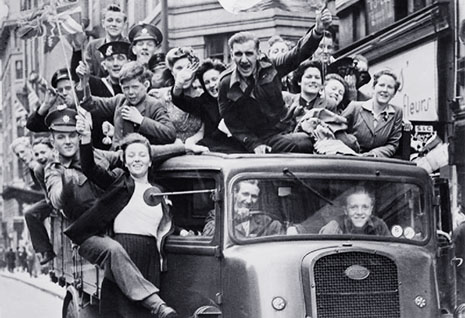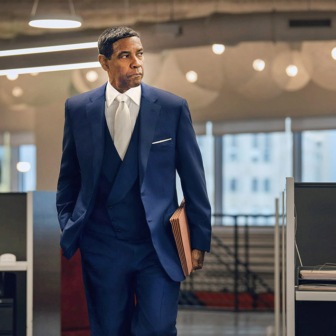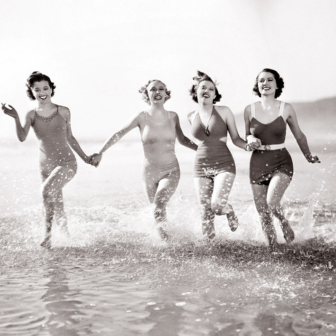THE scene is the foyer of a little cinema in the north London village of Hampstead. The characters are a handsome young couple who emerge from a screening of the latest French romantic comedy. As they pass by, the girl says gaily to the boy: “Why does every film we see these days seem to be about us?!”
A year on, I recalled this moment after a Friday night viewing — this time in the northern English city of Leeds — of a new, hundred-minute documentary by the renowned director Ken Loach, best known for his piercing TV dramas of the 1960s and, more recently, many humane films of suffering, survival and struggle among Britain’s downtrodden. So recognisable is the world of The Spirit of ’45, so familiar its characters and narrative arc, that anyone engaged with Britain’s post-1945 history can be forgiven for thinking: “the story of my life!” All the more so with the news, on the following Monday morning, that the central villain of the piece — Margaret Thatcher — had died.
The deluge of fervent responses that followed, including Loach’s own (“the most divisive and destructive prime minister of modern times… It is because of policies begun by her that we are in this mess today”), gives his film an even greater political charge: a reminder that The Spirit of ’45 depicts a world we in Britain (presumptuous as the phrase sounds for this multinational and ever more diverse land) continue to live inside. About us, indeed.
WHAT, exactly, is The Spirit of ’45? As the film’s subject, it is the popular euphoria that greeted the end of a gruelling conflict, mixing survivors’ relief, a “never again” determination to banish the prewar ills of unemployment and poverty, and the conviction that the collectivist impulses enabling victory in war should be harnessed to build a socialist commonwealth. (“Generosity, mutual support and cooperation were the watchwords of the age,” says Loach.) This celebratory moment reached its apogee in the Labour Party’s electoral landslide in July 1945, and then merged seamlessly into its achievements in government: state ownership of industries and utilities, the creation of the National Health Service, or NHS, and new towns and housing estates.
Loach and his team uncover fascinating and often moving archive footage from before and after 1945, as well as from the year itself — the verminous slums of the 1930s and the marches of the unemployed, the jagged ruins left by Nazi air raids (“I only washed my windows yesterday!” a neighbour says), soldiers discussing the postwar prospects, women protesting at a lack of housing, then a quickening pace as reconstruction swings into action in the later 1940s. The accompanying mood music enhances the visual effect, with much use of the melancholic brass-band sound associated with northern England’s industrial working class.
The people’s voices and the drama of the 1945 election campaign are skilfully interwoven, with two influential documents — William Beveridge’s 1942 report on a new system of social insurance, and Labour’s manifesto, Let Us Face the Future — setting the scene. A florid Winston Churchill is shown being heckled by a bunch of cheerful youngsters (whose successors today might have organised the notorious street parties rejoicing at Thatcher’s demise), while Labour’s terse, modest Clement Attlee tells a smoky victory rally at Westminster Hall, “I ask your support to carry us through difficult years to the great era that is opening before us.”
All this is interspersed with the recollections of those who were there: retired dock workers in Liverpool on a childhood of poverty, old coalminers in Wales on the advent of “nationalisation,” former nurses on the birth of the new health system (treatment “cost you nothing — an unforgettable moment”). The dominant tone of these dignified elders is quiet pride, laced with anger at prewar conditions and a sense that history, then, was at last on their side. Everything — the archival film, the modern testimony — is in monochrome, conveying the seamlessness of past and present.
It’s lovely if treacly stuff, leavened by subtle warning notes from the veterans (on the NHS as a “model for socialism,” on public ownership as merely a change of managers). Then, a dark screen — and after fifty minutes, the film jumps thirty-four years, and there is Margaret Thatcher, basking in victory on the steps of 10 Downing Street (to a strange low sound from the cinema audience, combining growl and hiss). After the dawn, the fall.
Images and tone darken. A great regression is under way: industries privatised, the rich glorified, trade unions vilified, the workless multiplied, society polarised. The witnesses lament the erosion of public institutions (“the NHS is nearly the last”), the council-house sell-off, the triumph of the cash ledger (“if there’s need and no profit in it, need goes”) and the crushing of the great miners’ strike of 1984–85.
Now, a further generation on, the film comes to David Cameron’s Tories, intent on completing the job Thatcher started. Where, though, is the opposition? The answer is that working-class organisations have been hijacked by the middle class. The radical medic Julian Tudor Hart says that the “socially responsible, caring capitalism” which current Labour leader Ed Miliband talks about resembles the Arabian Phoenix: “everyone has heard about it, but no one has ever seen it” (which brings a release of laughter from the audience).
But the generation of 1945 remains defiant. In the end, there is hope amid the bitterness, and it lies in retrieving the spirit of that time. The carriers today include the Occupy movement, student protesters, and striking workers (here, a soaring brass rendition of William Blake’s “Jerusalem,” that most resonant of English radical hymns). They, however, can still benefit from the indelible experience of their elders. At the last, a double reprise: Attlee at that post-election rally welcoming the election of “a Labour movement with a socialist policy,” and the joyous scenes in Trafalgar Square on “VE Day” two months earlier — when, for the first time, in a stunning visual flourish, the screen erupts into colour.
THE third audience reaction of the night is the most sustained: warm applause as the words “Directed by Ken Loach” appear. It’s deserved, for the craft, the care, and the passionate devotion that informs the work. But a goodly share of the gesture may lean towards the man himself and the integrity of a fifty-year path whose many highlights include the memorable TV plays Up the Junction, Cathy Come Home, Days of Hope and The Price of Coal, and the feature films Kes, Raining Stones, Land and Freedom, The Wind That Shakes the Barley, and (most recently) The Angels’ Share. The vagaries of an insecure industry have left undimmed an artistic credo that combines “independent voice, social realism, and uncompromising political commitment” (as Anthony Hayward says in his very useful compendium, Which Side Are You On? Ken Loach and His Films).
Indeed, this pervasive commitment is Loach’s artistic driving force, present even in those of his films that resist overt didacticism. But there, the political impulse is realised in the sympathetic interplay of character and situation. In The Spirit of ’45, as more often in Loach’s documentaries than in his feature films, the impulse is at the forefront. This makes it a most revealing film, for it’s also a manifesto. He may seem, in the first half especially, to be indulging viewers, but by the end it is clear he is inviting them: to join a party, to become an us.
This is made explicit after the screening, when an hour-long discussion held at the London launch of the film weeks earlier is shown, with Loach — alongside the comedian Jeremy Hardy, the ubiquitous polemicist Owen Jones, and the pensioners’ champion Dot Gibson — proposing “a new movement on the left”: “There is a possibility for a new spirit so let’s see if we can do it!” Those gathered at Brixton’s Ritzy cinema cheer, though their Leeds counterparts are silent; by this time — almost 11 pm — they are ready for home (or the pub), and begin to shuffle out. It’s an odd anticlimax.
But also instructive. The London event is a bores’ gallery, a reminder of the far left’s talent for draining the life from everything it touches. True, the genial crowd at the century-old “picture house” in the Hyde Park area of Leeds — median age around forty-five — embraces a few paper-selling comrades in its empathetic aura. There are, though, few signs of willingness to be conscripted.
On the way out, I speak to a couple in their fifties who agree that The Spirit of ’45 is not nostalgic, but relevant to the present. The man, good-looking with a donnish air and a soft west Yorkshire accent, says, “We are Labour Party members, so we still think that’s the best way forward.” One of a pair of bright women friends in their sixties tells me that “it was good to be reminded of the history you’ve lived through,” but that the filmed discussion was too much. Then in the crowded entrance to the foyer I tune into a quiet conversation between two smart women in their forties; one of them, wearing a fetching tartan scarf, says, “As you get older you understand the resilience of power,” and that it’s “easy to despair.”
We talk for several minutes: about whether The Spirit of ’45’s politics are naive, about whether only a cross-class alliance can bring change in this country, about how you have to be clever as well as angry. They say the postscript made the evening too long, and we concur that the film itself, its truth as social document and political argument, should be the focus of public discussion.
We part into the night on good terms. All these companions, after all, I reflect on the long walk back to Leeds railway station, are also my “us.” I recall George Orwell’s phrase, one I have always loved for the reluctance of its embrace: “I belong to the left and must work inside it.” But also Tony Harrison’s — son of Leeds turned England’s finest living poet — about “memory strangled by oblivion.”
FOR I’m also — only the Scots word will do — scunnered by The Spirit of ’45. First, for the sheer falsity of its depiction of the 1940s, whose true emotional–political textures are so much more complicated and interesting than Loach’s fairy story allows. (The rich evidence is in David Kynaston’s mind-blowing Austerity Britain, 1945–51). From the intellectual roots of Labour’s program, which the historian Gareth Stedman Jones once called the last flowering of Edwardian liberalism, to the variations in public experience and mood in the hard-pressed postwar years, this period is traduced by Loach’s comforting fantasy. This matters, because historical understanding — and any change-making democratic project — can only be built on truth.
Second, for the annihilation of the almost three decades between 1951 and 1979, as if the unwinding of the post-1945 settlement by Margaret Thatcher and her “ism” came out of nowhere. The film’s Manicheanism is a crime against history. Again this matters, for by portraying Britain’s modern era without complexity and contingency, Loach is promulgating a delusive view of how her change happened — or of how any new change can happen. This makes The Spirit of ’45 an engine of miseducation and, in the end, disempowerment.
Third, for the subterfuge of its anodyne description of witnesses who in many cases are veteran cadres in various far-left cults. John Rees, Alan Thornett, Tony Richardson, Dot Gibson, Tony Mulhearn — for years dedicated habitués of the Socialist Workers Party–Workers Revolutionary Party–Revolutionary Socialist League underworld — are depicted as “writer,” “shop steward,” “carworker” or “former councillor,” as if their revolutionist fantasies are incidental rather than central to their world view. Again this matters, because it is deceives the viewer and is an act of complicity with the manipulative politics they espouse.
Fourth, for the distorting political lens. Ken Loach has spent a lifetime pouring acid on the Labour Party. He regards all its leaders as sell-outs and traitors. (In an autobiographical statement in 1997, he declared that a “recurring theme” of his collaborative work “has been to explore the two curses of the labour movement: Stalinism and Social Democracy, the latter exemplified by the Blairite project of trying to give a radical gloss to hard-line capitalist politics.”) Now, The Spirit of ’45 seeks in effect to annex the achievements of post-1945 social democracy to a sectarian agenda in the present. (“A sort of compromise was possible after the war, but not now,” says Loach. “Capitalism is out to destroy the welfare state.”) Again this matters, because it fuels the self-damaging anti-political nostalgia that is already widespread on the left.
This “spirit of 2013,” where rhetorical excess and attitudinising colonise the political space, is visible most recently in the playpen anti-Thatcher “death protests” that continued right up to the former prime minister’s funeral on 17 April. (The case is well made by Eilis O’Hanlon in Ireland’s Sunday Independent and Sam Leith in London’s Evening Standard.) Just as Thatcher gave conservatism a radical energy, these events reflect the process in reverse: invoking the past, when consoling Thatcher-hatred made life meaningful, as a defence against a feared future.
In the 1990s the much-missed critic Gilbert Adair (who died in 2011), reviewing one of Ken Loach’s dramas of deprived youth in bleak post-industrial western Scotland, called him “the most conservative film-maker in Britain.” Adair’s point — and this sophisticated Francophone, though he kept it quiet, was himself born in Kilmarnock — was that Loach’s artistic focus became a deterministic entrapment of its world and characters, a romanticising of marginality, and a denial of the reality of change and of moral agency. All of them deeply reactionary. That acute judgement, impossibly shocking and radical at the time, encapsulates The Spirit of ’45. For this very reason, the film should be seen and discussed as widely as possible. •




